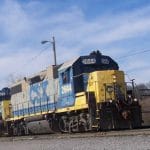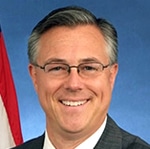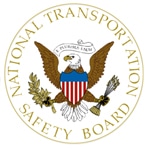The Associated Press reported Dec. 20 that an analysis by the federal Department of Transportation (DOT) did not take into account up to $117 million in damage reductions when considering the repeal of a Federal Railroad Administration (FRA) rule requiring the installation of electronically controlled pneumatic (ECP) brakes on tanker cars.
The DOT repealed the 2015 rule requiring the installation of the advanced braking system on DOT-117 tank cars that carry explosive fuels in late 2017.
AP reviewed federal documents and found that the damage estimates used by the DOT varied widely between the Obama administration, which enacted the ECP rule, and the Trump administration, which repealed the rule.
“Under Obama, the Transportation Department determined the brakes would cost up to $664 million over 20 years and save between $470 million and $1.1 billion from accidents that would be avoided,” the AP’s Matthew Brown wrote. “The Trump administration reduced the range of benefits to between $131 million and $374 million. Transportation department economists said in their analysis that the change was prompted in part by a reduction in oil train traffic in recent years, which meant there would be fewer derailments. But in making their calculations, they left out the most common type of derailments in which spilled and burning fuel causes property damage but no mass casualties …
“Department of Transportation officials acknowledged the mistake after it was discovered by the AP during a review of federal documents, but said it doesn’t change their decision not to install the brakes,” Brown wrote.
SMART Transportation Division supported the ECP brake rule for the safety benefits that would have been gained and in Nov. 2017 National Legislative Director John Risch made detailed comments to the Pipeline and Hazardous Materials Safety Administration (PHMSA) in support of ECP braking technology.
The Association of American Railroads had lobbied for repeal of the rule since its 2015 inception.
Read the complete Associated Press story.
Tag: ECP brakes
The Bellingham Herald reports that last week the Department of Transportation’s Pipeline and Hazardous Material Safety Administration (PHMSA) decided to repeal a rule that required electronically controlled pneumatic (ECP) braking systems be installed on all oil trains.
The original rule was intended to increase safety and help prevent the derailment and puncturing of cars. DOT’s original analysis of ECP brakes found that they “can reduce the number of cars in a derailment that puncture and release their contents by almost 20 percent compared to other braking technologies.”
With conventional air brakes, the braking message must go through each car individually before moving on to the next car; this process can take up to two minutes for the brake application to reach the back of a freight train. ECP braking uses electronic controls that applies the brakes to all cars consistently and at the same time, providing more control and shortening the stopping distance, which leads to a lower risk of derailment or coupling breakage.
Washington state Governor Jay Inslee criticized the repeal, saying in a press release that the decision to repeal is a “reckless disregard for the life and property of all who live or work along the rail tracks.”
“I fear the day we witness a destructive or deadly derailment that could have been prevented with readily available technology,” he said.
The PHMSA cited a reduction in benefits to the rail carriers from $254 million in benefits to businesses and $215 to $358 million in savings related to safety when the first analysis of ECP braking was done, down to $131 to $198 million in total benefits, as the reason for their repeal of the rule. PHMSA said the lower estimates stem from a decrease in the amount of oil being transported by rail.
The Association of American Railroad (AAR), an organization representing rail carriers, praised the repeal, while Inslee, environmental groups and unions protest this reduction in safety.
Click here to read the full story from the Bellingham Herald.
The WashingtonPost.com recently reported that the rail industry is lobbying hard to stall or potentially reverse the FRA’s ruling that freight trains be equipped with ECP (electronically controlled pneumatic) brakes by 2021. Despite the growing number of rail crashes and fatalities involving freight cars transporting flammable liquid, and the growing consensus that ECP is vital to freight rail safety, rail lobbyists are angling for support from the Trump administration to roll back this and other safety mandates.
John Risch, SMART TD Legislative Director, who was interviewed for this article, described ECP brakes as “the foundation of safety in the future of the rail industry….ECP brakes can save the day.” Read the complete article here.
SMART TD Legislative Action Center: Contact your elected representative to voice your support of lifesaving ECP brake systems on all trains by clicking here.

On December 3, 2015, Congress passed H.R. 22, the Fixing America’s Surface Transportation Act (FAST ACT) by overwhelming bipartisan votes of 83 to 16 and 359 to 65 in the Senate and House respectively. The legislation is the first long-term surface transportation reauthorization in a decade and provides funding and policy changes for our nation’s highways, mass transit and rail systems. This landmark legislation includes a number of SMART TD policy priorities, many of which are outlined below.
“I’m very pleased with the legislation overall compared to some of the original proposals. The legislation was modified in both houses and in the conference committee to correct many of the harmful issues facing our membership,” SMART TD President John Previsich said.
“Our National Legislative Director John Risch and his team, working with other unions and allies did a stellar job on a very complex 1300-page piece of legislation that was passed through a very complicated legislative process.

“In difficult economic and political times, an effective legislative department makes all the difference and we have one of the best in the business.”
“Considering the makeup of the Congress, overall we are pleased with the policy provisions in this legislation, and that the law covers five years of authorization,” said Risch. “However, we are disappointed that much of the funding came from non-user fees. Freight railroads alone fund their own track and infrastructure. Using general funding for highways puts railroads at a competitive disadvantage because trucks are not paying their fair share of costs for highway construction and maintenance.”
Provisions to protect transit members from assault
- Section 3022. Improved Public Transportation Safety Measures
- This much-needed section will better protect our transit members by requiring the Federal Transit Administration to promulgate regulations to protect public transportation operators from assault.
- The rulemaking will be required to consider the safety needs of drivers in different modes, including bus and light rail.
- This provision was a direct result of a joint lobbying effort by SMART TD, the AFL-CIO’s Transportation Trades Department (TTD), AFL-CIO, the Transport Workers Union (TWU) and the Amalgamated Transit Union (ATU).
ECP brake mandate is maintained
- The legislation largely protects the May 2015 Pipeline and Hazardous Materials Safety Administration (PHMSA) rule that requires the use of electronically controlled pneumatic (ECP) brakes on certain high-hazard flammable trains (HHFTs), which SMART TD strongly supports.
- While the legislation does require another study on ECP brakes, it also includes language supported by SMART TD that will ensure testing is done independently and objectively, and not by the railroads or other entities affected by the rule.
- Additionally, the legislation neither prohibits DOT from moving forward with the May 2015 rule while the study is in progress, nor does it require DOT to issue a new rule dependent on the study’s findings.
- The original Senate Commerce Committee language would have repealed the ECP rule and replaced it with a railroad-dominated study.
Inward-facing cameras cannot be used to retaliate against employees.
- Working with Senator Richard Blumenthal (D – Conn.), SMART TD secured a provision stating that any in-cab audio or image recording obtained by a railroad carrier under this section may not be used to retaliate against an employee. Rail Subcommittee Chairman Jeff Denham (R – Calif.) reinforced this provision by specifically mentioning it in a House floor speech.
- We are pleased the final bill removed a requirement for efficiency testing.
Removed harmful privatization language for transit projects
- Working with TTD and other transit unions (TWU and ATU), SMART TD helped strip a harmful privatization provision from the legislation. The provision would have been an unprecedented giveaway to the private sector by allowing certain public-private partnerships to move to the front of the line for grant awards simply because the project included private money, with no minimum threshold.
- This provision – if not changed – could have resulted in lost jobs, lower wages and diminished passenger rail and transit service.
Biased hair testing methods rejected
- SMART TD has strongly opposed the unfair and biased use of hair testing for drug tests.
- SMART TD strongly opposed previous versions of this legislation that would have allowed companies to immediately begin testing an employee’s hair for drugs.
- The final legislation would only allow companies to do so after experts at the Department of Health and Human Services have set guidelines for such testing.
Tank car safety standards
- The legislation makes substantial improvements in tank car standards by requiring that all new tank cars are equipped with one-half inch thermal blankets.
- All existing DOT-111 tank cars transporting flammable liquids are required to be upgraded to retrofit standards regardless of product shipped.
Alerters
- The legislation requires DOT to promulgate a rule requiring working alerters in the controlling locomotive of each commuter and intercity passenger train.
Signal Protection
- The legislation requires DOT to initiate a rulemaking for redundant signal protection for Maintenance of Way (MOW) workers.
PTC Grants
- The legislation provides $199 million to finance a competitive grant program for PTC implementation on commuter railroads.
Funding: Amtrak and Transit
- Transit programs will receive a 9 percent funding increase in Fiscal year 2016 over FY 2015 levels and 2 percent increases each year through 2020.
- Amtrak is funded through the appropriations process; however, this legislation increases authorized FY 2016 funding levels for Amtrak by $60 million.

The new brake rules were issued by the DOT in May, and included phasing in tougher tank car standards and new electronically controlled pneumatic braking systems on any trains carrying more than 70 cars of crude oil by 2021. On November 11, the agency’s Pipeline and Hazardous Materials Administration denied appeals against the rules.
Read more from Jacksonville Business Journal.

The Hazardous Materials Regulations provide a person the opportunity to appeal a PHMSA action, including a final rule. PHMSA received six appeals regarding the final rule, one of which was withdrawn.
The five remaining appeals were submitted by the Dangerous Goods Advisory Council (DGAC), American Chemistry Council (ACC), Association of American Railroads (AAR), American Fuel & Petrochemical Manufacturers (AFPM), and jointly the Umatilla, Yakama, Warm Springs, and Nez Perce tribes (Columbia River Treaty Tribes) and the Quinault Indian Nation (Northwest Treaty Tribes).
Dangerous Goods Advisory Council
The DGAC contends that the applicability of the final rule should be limited to the transportation of crude oil and ethanol trains, which, it says, was the stated intention of the rule. DGAC argues that, if the Department wishes to pursue enhanced tank car standards and operational requirements for other Class 3 (flammable liquid) materials, it should do so in a separate rulemaking.
American Chemistry Council
ACC believes that the scope of the final rule will inadvertently affect nearly 40,000 legacy DOT-111 tank cars that transport Class 3 flammable liquids that were not accounted for in the accompanying RIA. ACC states that because a shipper cannot know how a carrier will assemble a train, the possibility that a shipper’s tank car will be placed into an HHFT will force all shippers of Class 3 materials to retrofit or purchase tank cars to meet the DOT-117R or DOT-117 specification. ACC believes that, coupled with a retrofit timeline that does not match the Canadian timeline, the final rule will fail to properly address the risks associated with hazardous materials offered and transported in unit trains.
Association of American Railroads
AAR contests the scope of the final rule because it permits shippers to continue to package Class 3 flammable liquid materials in tank cars that do not meet the new DOT-117 tank car standard. AAR states that PHMSA has created two pools of tank cars, those that meet the heightened standard for HHFTs and those that do not. As a result, AAR asserts, shippers may continue to offer Class 3 flammable liquid materials in DOT-111 tank cars as long as the DOT-111 is not placed in an HHFT. According to AAR, this places an unjustified burden on the railroads to continuously analyze the composition of each train transporting Class 3 flammable liquid materials in DOT-111 tank cars. AAR claims that PHMSA’s argument, that through fleet management the railroads can avoid this issue, is baseless. AAR believes that PHMSA should harmonize with Canada by banning the use of DOT-111 tank cars for transporting any Class 3 flammable liquid materials. By failing to harmonize with Canada in this respect, AAR contends that the U.S. market will become flooded with legacy DOT-111 tank cars, which will further exacerbate the fleet management challenges U.S. railroads will face to construct trains to avoid meeting the definition of an HHFT. To support its appeal, AAR submitted waybill data from its subsidiary Railinc showing numbers of flammable liquid shipments tendered in smaller groups of cars that do not by themselves meet the definition of an HHFT. Data from the first quarter of 2015 illustrate that 37,000 cars of flammable liquids (other than crude oil and ethanol) were tendered in blocks of 20 cars or fewer. During the same period, 37,576 tank cars of other flammable liquids (other than the 25,009 tank cars of crude oil or 39,956 tank cars of ethanol) were tendered in groups of fewer than 35 cars. According to AAR, had the final rule been in effect, a total of 102,541 cars of flammable liquids could have moved in existing DOT-111s. AAR contends that PHMSA should specify a sunset date for discontinuing the use of DOT-111 tank cars for hazardous materials not in an HHFT.
Summary of PHMSA and FRA response
PHMSA denies the appellants’ (DGAC, ACC, AAR, AFPM, and Treaty Tribes) appeals on Scope of Rulemaking, Tribal Impacts and Consultation, Retrofit Timeline and Tank Car Reporting Requirements, Thermal Protection for Tank Cars, and Advanced Brake Signal Propagation Systems. We conclude we reasonably determined how to apply new regulations and provided the regulatory analysis to support those decisions. While we understand that shippers, carriers, and tank car manufacturers for Class 3 flammable liquids will face new challenges in the wake of these regulations, we maintain that they are capable of complying with the final rule. We also deny DGAC’s appeal to eliminate or provide further guidance for the Sampling and Testing program. The sampling and testing program is reasonable, justified, necessary and clear as written. Additionally, we disagree that a delayed compliance date of March 31, 2016 should be provided for implementation of the requirements in § 173.41 for shippers to implement changes for training and documentation.
With respect to Information Sharing/Notification, PHMSA announced in a May 28, 2015, notice that it would extend the Emergency Order applicable to the topic of Information Sharing/Notification indefinitely, while it considered options for codifying the disclosure requirement permanently. Furthermore, on July 22, 2015, FRA issued a public letter instructing railroads transporting crude oil that they must continue to notify SERCs of the expected movement of Bakken crude oil trains through individual States. While the treaty tribes and other stakeholders will have the opportunity to comment on these future regulatory proposals in the course of that rulemaking proceeding, PHMSA will continue to seek opportunities to reach out to the tribes and consultation from tribal leaders.
Click here to read the full ruling.

FRA was the lead agency tasked with responding to and investigating the February accident. Following a thorough investigation, the FRA announced the cause of the derailment to be a broken rail, resulting from a vertical split head rail defect. The defect that eventually resulted in the derailment was missed by CSX, and their contractor, Sperry Rail Service, on two separate inspections in the months leading up to the accident.
In addition to announcing the cause of the derailment, FRA also provided a path forward to prevent similar rail-caused accidents in the future:
- The agency announced it will release a Safety Advisory, which urges closer and more detailed inspections where defects and flaws are suspected, and stronger training for rail inspection vehicle operators
- FRA announced it will explore the need for rail-head wear standards and potentially require railroads to slow trains or replace a rail when certain conditions pose a safety risk
- FRA secured a commitment from CSX to require internal rail flaw operators to review previous inspection data alongside real-time data in order to assist in identifying conditions and flaws that have changed or worsened between inspections
“Our country relies on the safe transportation of large quantities of energy products across the nation, and it is our responsibility to require operators to implement strict safety standards,” said U.S. Transportation Secretary Anthony Foxx. “FRA’s findings and action today should make it clear to rail operators that we will do exactly that.”
The cause of the derailment – the vertical split head broken rail – was missed in at least two separate rail inspections in December 2014 and January 2015. Data from both inspections show evidence of the defect, but neither CSX or CSX’s contractor, Sperry Rail Service, discovered the defect which led to the broken rail. FRA has issued $25,000 fines against both CSX and Sperry Rail Service for failure to verify a potential rail defect.
The broken rail was also near the location of a previous broken rail discovered by an FRA inspector and repaired in May 2014.
“When we see a need for action, we will take it, and that is what FRA is doing today. Broken rail is one of the leading causes of accidents. Railroads moving crude and other hazardous materials through and alongside communities bear significant and special responsibility. All railroads, not just CSX, must be more diligent when inspecting for internal rail flaws or when contracting out inspection work,” said FRA Acting Administrator Sarah Feinberg. “This is just our latest effort to increase the safe transportation of crude and other energy products.”
Over the last two years, the U.S. Department of Transportation (DOT) has taken more than two dozen actions to improve the safety of the transport of crude and other flammable liquids. In May 2015, DOT released its final, comprehensive rule that raises the bar on the safe transportation of flammable liquids by rail. The rule requires stronger tank cars and a better, faster, more efficient braking system – electronically controlled pneumatic (ECP) brakes. ECP brakes can reduce the distance and time needed for a train to stop and keep more tank cars on the track in the event of a derailment. The DOT rule also supplements FRA’s actions to add an Automated Track Inspection Program car to inspect crude routes, focus track inspectors on crude routes via our CORETEX program, and secure voluntary agreements from railroads to inspect track more frequently than current regulations require.
Read the accident findings report: Accident Findings Report.

Szabo
CHICAGO – As a former railroad brakeman, the region’s top planner Joe Szabo knows how to stop a train.
So it’s significant he backs a controversial new federal rule requiring freight railroads to install electronic braking systems on trains carrying crude oil and ethanol.
Shiploads of volatile fuel are increasing in the Chicago region with about 40 crude oil trains a week, data that concerns suburban mayors and fire departments wary of a worst-case scenario.
Read more from the Daily Herald.

The study shows that Electronically Controlled Pneumatic (ECP) brake systems out-performed distributed power configurations, which in turn out-performed conventional brake systems. The study provides detailed description and analysis of each rail braking system and the stopping distances they achieved under various circumstances.
“Over the last decade, the NTSB has investigated a number of catastrophic flammable liquid unit train derailments. Our recommendations have called for improved technologies that can reduce or minimize the risk of derailments. Improved braking capabilities are but one part of the equation in making rail transportation safer,” said NTSB Chairman Christopher A. Hart.
The NTSB considered emergency and full service brake applications on uniform grade, tangent track with clean, dry rails. The study also evaluated the effect of different net braking ratios, which measure the amount of force applied by the brake shoes against the wheels. While ECP brake systems performed best, increasing the net braking ratio for any brake system substantially improved its stopping performance.
The NTSB’s investigation of the Casselton, ND accident is ongoing. Analysis of the accident, along with a determination of probable cause, will come later when the investigation is completed.
To read the study, click on the following link: http://go.usa.gov/3Gz6P.

But as firms such as Exxon Mobil Corp., Hess Corp. and CSX Corp. led one last lobbying blitz, several environmentalist and labor organizations paid their first visits to the White House’s Office of Information and Regulatory Affairs (OIRA) as it weighed the final regulations.
John Risch, national legislative director for the SMART union’s transportation division, said his group’s March 30 meeting at OIRA stemmed from a desire to do “something different” about the oil safety rule, which touches on everything from train speed to tank car design. OIRA is a small but influential part of the Office of Management and Budget that analyzes the costs and benefits of a given rule before it goes public.
“I saw actually a press clip that the railroads had met with [OIRA] and I thought, ‘Wow, I’m missing a step here,’ so I requested to meet with them,” Risch said, noting that SMART-TD had filed comments on an earlier draft of the crude-by-rail rule in addition to working with the Federal Railroad Administration.
Earlier in the month, representatives from the environmental group Earthjustice sat down with OIRA to call for a ban on the oldest, least crash-worthy type DOT-111 tank cars still used to haul thousands of barrels of crude across the country each day. Other organizations present at the March 13 meeting included ForestEthics, Riverkeeper and the Sierra Club, all of which have voiced concerns about a string of recent oil train derailments and explosions.
Earthjustice again met with OIRA on April 15, just two weeks before the release of the final rule.
“We’re starting to see more and more people get engaged on this rule because these tank cars are rolling through towns and communities across the country,” said Jessica Ennis, a senior legislative representative with Earthjustice who lobbies on a range of topics important to the organization. “Every time there’s another explosion, more people are realizing that carrying crude oil by rail is actually very dangerous.”
The new Department of Transportation rule aims to make that process less dangerous by toughening new tank car standards and requiring shippers to update older cars on a 10-year time frame. The rule also caps oil and ethanol trains’ speed limits at 40 mph through most big cities and 50 mph elsewhere.
Environmentalist groups have been largely critical of the final rule, noting that it applies only to trains with 20 or more tank cars and follows a too-leisurely phaseout schedule.
Brakes added
Risch of SMART-TD is more satisfied with the rule.
At the meeting he called for in March, Risch pushed transportation regulators to make railroads add electronically controlled pneumatic brakes — a technology the North Dakota native hailed as “the greatest safety enhancement I witnessed in my 30-year career as a locomotive engineer.”
The final rule would require trains carrying 70 or more cars of the most flammable kinds of crude to use ECP brakes by 2021 or face a 30 mph speed limit, with other “high-hazard flammable unit trains” following suit by 2023.
The rail, oil and tank car industries had fought an ECP braking mandate as expensive and unnecessary, with Ed Hamberger, head of the Association of American Railroads, calling their requirement a “rash rush to judgment” on the part of DOT.
Risch acknowledged that the shift to ECP technology would come at a cost but called DOT’s 2021 initial deadline a “reasonable approach.”
“It’s not radical like it’s being portrayed,” he said.
Green groups led by Earthjustice had hoped for faster and broader application of ECP brakes, which government analyses said would reduce the severity of oil train accidents by up to 36 percent compared to regular braking systems.
Environmentalists had also sought to draw attention to the towns affected by the DOT rulemaking, with Ennis of Earthjustice helping schedule a conference call between Obama administration officials and council members from several cities.
“I think these meetings are extremely important, especially with local elected officials — they’re closest to where these accidents can happen across the country,” Ennis noted. “They have a unique, on-the-ground perspective on this that’s very important for the DOT to hear.”
Shannon Williamson, a City Council member in Sandpoint, Idaho, participated in the April 15 conference call with OIRA and called the conversation an “absolutely critical opportunity.”
Sandpoint is a hub for westbound crude from North Dakota’s Bakken Shale play, where the bulk of the nation’s oil-by-rail shipments originate. Oil train traffic rose from about 15 oil trains per week to 23 in the span of a year, said Williamson, who is also executive director of the environmental nonprofit Lake Pend Oreille Waterkeeper.
She added that her town is about the same size as Lac-Mégantic, Quebec, where a 72-car train hauling Bakken crude derailed and exploded in July 2013, killing 47 people.
That disaster set into motion the rulemaking unveiled Friday, which was a joint effort between U.S. and Canadian regulators.
“The oil industry had lobbyists in the administrative offices practically every single day during this whole rulemaking,” Williamson said. “The people who are going to be impacted by oil-by-rail transport are not being adequately represented — or they weren’t.”
This story was written by Blake Sobczak and originally appeared on EnergyWire and was reposted with permission from Sobczak.